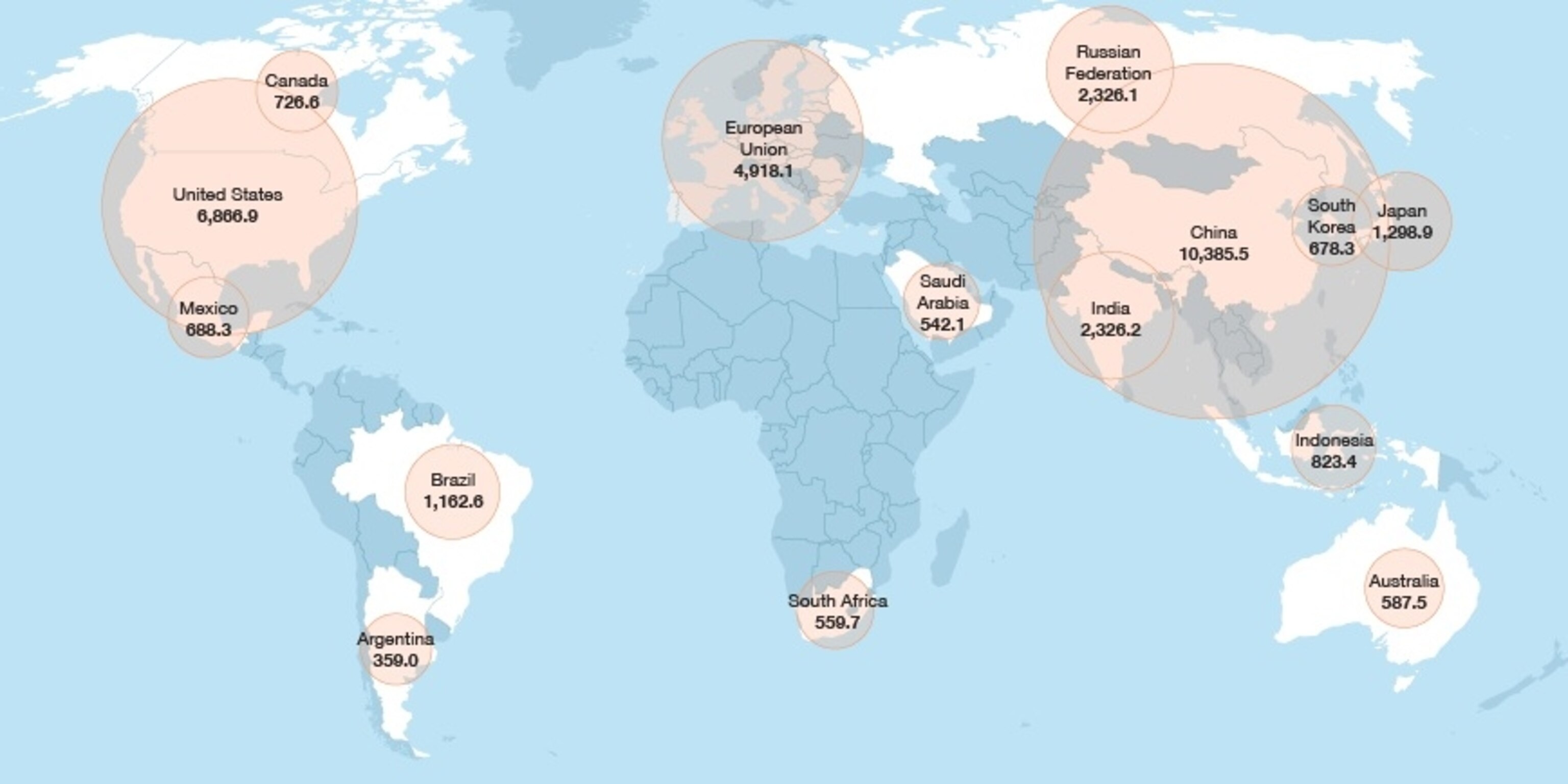
The Changing Carbon Map: How We Revised Our Interactive Look at Global Footprints
At climate change talks in Warsaw this week, just as in the previous 18 annual rounds of negotiations, delegates never were able to overcome the divide between rich and poor nations.
We map the starkly different views of the climate crisis that have led to stalemate in our newly revised interactive,
. (See related “
Quiz: What You Don’t Know About Climate Change Science
.”)
Our map zeroes in on just a small number of nations–14–but they happen to be responsible for 80 percent of the world’s carbon emissions. The numbers come from the World Resources Institute’s excellent climate data navigator, CAIT 2.0, one of the few data sources that enables apples-to-apples comparisons of emissions from around the world.
Each of the four viewpoints in our map is accurate, as far as it goes. But each alone is inadequate. Like the legendary blind men surveying the elephant, nations that contemplate the massive global warming problem from only one vantage point will end up groping at a portion of the truth and griping at each other, missing the whole picture. (See related, “Q&A With Philippines Climate Envoy Who’s Fasting After Super Typhoon Haiyan.”)
For the United States and most other industrialized nations, the operative view is “Current Emissions,” and the alarming reality that China’s carbon output has grown more than 40 percent, and India’s, by 25 percent, since our last version of the map, based on 2005 data. (See related “Pictures: A Rare Look Inside China’s Energy Machine.”) Any treaty that is designed like the Kyoto accord, with binding carbon emissions cuts only for the richest countries, will fail to stem the rising threat of Asia’s rapidly mounting emissions.
The U.S. and Europe often point to the climate progress they’ve made by focusing on what we call “Intensity,” on our map, their relatively low greenhouse gas emissions per unit of economic output. Indeed, carbon intensity has fallen dramatically in wealthy nations over the past few decades. But no nation is an island, and these efficiency improvements are in part because energy-intensive manufacturing has moved to the developing world, often to make goods that are being shipped, bought and consumed in the developed world. And even if all nations were reducing their intensity, it would matter little if absolute emissions are rising at their current rate.
Developing nations frequently rebuff calls that they face binding emissions cuts, pointing to their low “Per Capita” emissions, compared to the giant footprint of the United States and other wealthy countries. Several years ago, India in particular made
the cornerstone of its climate policy, but the trends here too are alarming. India’s per capita carbon emissions are up 12 percent since our previous map, China’s are up 40 percent and now nearly on par with those of Europe. The atmosphere will be overwhelmed if per capita emissions continue to grow at this rate in nations with large and growing populations, and yet these countries still face the very real and necessary challenge of extending electricity to millions of people living in poverty and without access to the grid. (See “Related: Five Surprising Facts About Energy Poverty.”)
But most of the debate in Warsaw has centered around the title on our map called “Cumulative Emissions.” When measured since the start of the Industrial Revolution, the greenhouse gases released to the atmosphere by the United States and Europe far surpass those of any single developing nation. If, as the scientists now say, the world has a limited “
” and more than half of it already has been spent, developing nations point out that the United States and Europe have burned up more than their fair shares of fossil fuel on their paths to economic progress.
Cumulative emissions are about more than emissions, they are now about money. Wealthy nations have long promised to establish a fund to bolster the defenses of those at the greatest risk of sea level rise and extreme weather. Developing countries now want to see that funding plus an additional mechanism for the nations with the largest cumulative emissions to compensate the poorer, vulnerable nations for “loss and damage” due to climate events. They could point to one example playing out in real time, the tragedy unfolding in the Philippines after Super Typhoon Haiyan.
But cumulative emissions, too, are changing. Just prior to the Warsaw talks, the United Nations Environmental Program released its “
” report, showing how nations’ current commitments on climate change fall well short of what’s needed to curb the risk of catastrophic global warming. UNEP noted that until about the year 2000, it was clear that the wealthy nations’ historic emissions far outweighed those of the poor countries. Since then, emissions have grown so rapidly in the developing world since then that the balance has changed significantly. Now, developed nations and developing nations’ share roughly 50-50 responsibility for the atmosphere’s cumulative carbon load since 1850.
Recent
research on cumulative emissions
cited by the UN, by the Joint Research Center of the European Commission and PBL Netherlands Environmental Assessment Agency, shows how tricky a single viewpoint of emissions can be. Some have suggested for example, discounting some past emissions to account for technological progress. The authors point out that the United Kingdom, for instance, had a long history of high emissions due to the use of inefficient steam engines. But nations developing today don’t need to repeat that history; they can employ much more advanced technologies and emit far less carbon for the same level of economic output.
Another way to look at cumulative emissions, the authors point out, is to grant each nation a “deduction,” so to speak, for “basic needs.” In this approach, nations would not be held responsible for the carbon emissions necessary to meet the basic needs of their people.
Discounting past emissions to account for technological progress would tend to lessen responsibility for wealthy nations, while deductions for “basic needs” would lessen the pressure on poorer and developing nations. But the recent research on cumulative emissions underscores the point of our interactive map, the importance of looking at the world’s climate crisis globally and from many different points of view, and not just from the poor frame of reference circumscribed by any one nation’s borders.
Related Topics
You May Also Like
Go Further
Animals
- How can we protect grizzlies from their biggest threat—trains?How can we protect grizzlies from their biggest threat—trains?
- This ‘saber-toothed’ salmon wasn’t quite what we thoughtThis ‘saber-toothed’ salmon wasn’t quite what we thought
- Why this rhino-zebra friendship makes perfect senseWhy this rhino-zebra friendship makes perfect sense
- When did bioluminescence evolve? It’s older than we thought.When did bioluminescence evolve? It’s older than we thought.
- Soy, skim … spider. Are any of these technically milk?Soy, skim … spider. Are any of these technically milk?
Environment
- Are the Great Lakes the key to solving America’s emissions conundrum?Are the Great Lakes the key to solving America’s emissions conundrum?
- The world’s historic sites face climate change. Can Petra lead the way?The world’s historic sites face climate change. Can Petra lead the way?
- This pristine piece of the Amazon shows nature’s resilienceThis pristine piece of the Amazon shows nature’s resilience
- Listen to 30 years of climate change transformed into haunting musicListen to 30 years of climate change transformed into haunting music
History & Culture
- Meet the original members of the tortured poets departmentMeet the original members of the tortured poets department
- Séances at the White House? Why these first ladies turned to the occultSéances at the White House? Why these first ladies turned to the occult
- Gambling is everywhere now. When is that a problem?Gambling is everywhere now. When is that a problem?
- Beauty is pain—at least it was in 17th-century SpainBeauty is pain—at least it was in 17th-century Spain
Science
- Here's how astronomers found one of the rarest phenomenons in spaceHere's how astronomers found one of the rarest phenomenons in space
- Not an extrovert or introvert? There’s a word for that.Not an extrovert or introvert? There’s a word for that.
- NASA has a plan to clean up space junk—but is going green enough?NASA has a plan to clean up space junk—but is going green enough?
- Soy, skim … spider. Are any of these technically milk?Soy, skim … spider. Are any of these technically milk?
Travel
- Could Mexico's Chepe Express be the ultimate slow rail adventure?Could Mexico's Chepe Express be the ultimate slow rail adventure?
- What it's like to hike the Camino del Mayab in MexicoWhat it's like to hike the Camino del Mayab in Mexico







